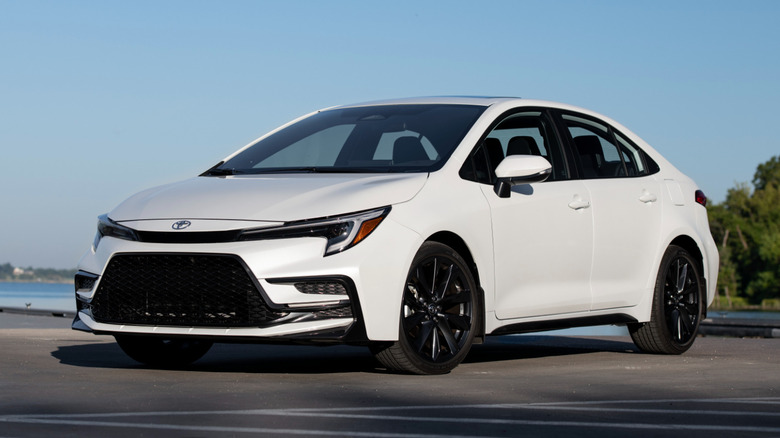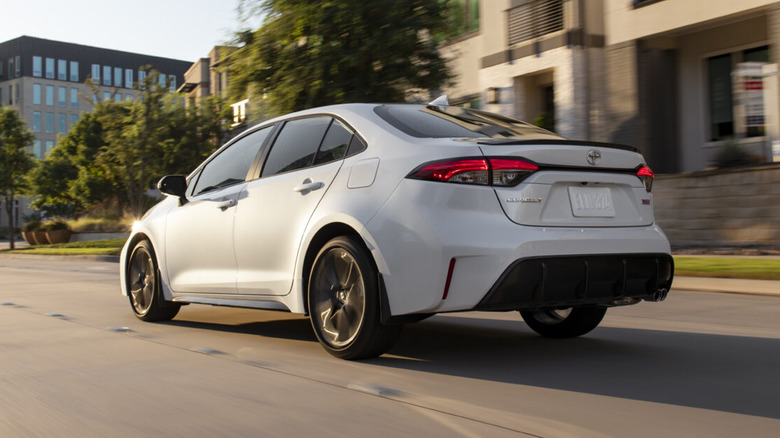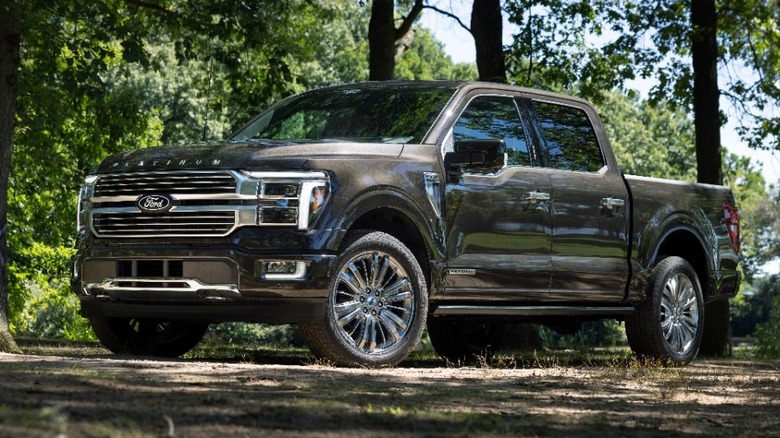5 Of The Oldest Cars Still In Production Today
The automotive landscape is littered with discontinued cars from the past that would be popular today. Nameplates like the Dodge Dakota and Nissan Xterra come to mind, not to mention the dearly (and recently) departed Chevy Camaro. Considering the Nissan Altima and Ford Escape are just two of more than a dozen long-running cars expected to be retired as soon as 2026, it may seem like automakers aren't interested in vehicular continuity.
However, digging into the details on the oldest cars still in production reveals just the opposite. Ford has been making the Mustang since 1964, and did you know the Toyota Land Cruiser dates to the 1950s? That's a long time, but it doesn't quite match the 90-year run of the very oldest car still in production as of 2025.
It's unlikely any of the car manufacturers that have been continually building a nameplate for 50 years or longer could have predicted this kind of longevity. And there does not seem to be a common thread as to how a car achieves this kind of status, but from sports cars and econoboxes to trucks and SUVs, each one of these long-running vehicles has earned icon status.
Toyota Corolla - 1966
With stats like one car sold every 15 seconds, availability in 150 countries, and more than 50 million units produced since 1966, it's easy to see why the Corolla takes first place among the most successful Toyota nameplates of all time. Debuting in 1966, the first-generation Corolla came with a 1.1-liter four-cylinder engine making just 60 horsepower.
Arriving on U.S. shores in 1969, it cost about $1,700, was 12 ½-feet long, and weighed only 1,521 pounds. Since then, the Corolla, which is named after the ring of petals around the central part of a flower, has transformed over 11 generations. Memorable models include the fifth-gen AE86 from the 1980s with its twin-cam 4A-GE engine that was the final run of rear-wheel drive Corollas and the seventh-gen 1990s Corolla that transitioned the small car into the compact class. From that point until the current series was unveiled in 2020, the Toyota Corolla was not exactly known as an exciting car.
Reliable, affordable, and practical, yes. Enthusiast-friendly? No. This all changed as Toyota brought forth a hotrod GR Corolla that joined a fuel-sipping hybrid for the first time in the Corolla lineup. The hybrid offered 53 mpg combined, while the GR all-wheel-drive hatchback delivered 300 riotous horsepower and a 6-speed manual. It marked a refreshing reinvention of a car that had arguably become staid and suggests that Toyota has no plans to retire the Corolla anytime soon.
Porsche 911 - 1963
Porsche's iconic 911 sports car was designed by F.A. Porsche, the son of company founder Ferry. Unlike the four-cylinder-powered 356, the new 911 featured a six-cylinder horizontally-opposed mill. Mounted out back, this basic configuration has remained consistent across every Porsche 911 generation from its 1963 debut through today. There have been major changes over that 62-year span, but even the basic profile of the 911 has remained the same. Of all the oldest cars still in production, the Porsche 911 perhaps does the best job of living an "if it ain't broke, don't fix it" life.
Highlights include the 993-generation Turbo S with its twin-turbo flat-6 good for 424 hp and a 0-60 mph split of 3.6 seconds. Built at the tail end of the 1990s, this was also the high point of air-cooled 911s as the following 996-generation ushered in water-cooled engines. By 2011, that move had proven savvy from a performance perspective as evidenced by 911s like the GT2 RS.
Sporting a 3.6L twin-turbo flat-6 rated for 620 hp and 516 lb-ft of torque, this street-legal racecar could go from 0 to 60 in 3.3 seconds, hit a top speed of 209 mph, and circle the skidpad with 1.07 gs of lateral grip. As of 2025, Porsche sells the 911 in 21 distinct models, including the off-road-ready Dakar, bonkers GT3 RS, and Turbo S with 640 hp and a sub-3-second 0-60 sprint time. Here's to hoping for more of the same from future Porsche 911s.
Chevrolet Corvette - 1953
Today, you can buy a Corvette ZR-1 with a twin-turbo V8 tuned up to, ahem, 1,064 horsepower and 828 torques. It'll go from 0-60 in 2.2 seconds, clear the quarter mile in less than 10 seconds, and hit 215 mph at the top end. This is outrageous performance and doesn't diminish the impressive metrics put up by the rest of the C8 Corvette lineup, but it is quite startling compared to the very first Corvette. Arriving in 1953, the C1 had a 150-horsepower inline-6 and Powerglide automatic transmission — not exactly the stuff of sports car fantasies.
Fortunately, by 1966, Chevy stepped up the Corvette's game with a 327 CID V8 making 340 hp paired with a 4-speed manual. Over all the Corvette generations that would follow, this formula was continually refined with Chevrolet never straying from its V8-powered focus. There was the C2 series with its 396 CID big-block V8 and the 5.7-liter LT1 V8 from the long-running C4 Corvette. Performance started to dial up significantly with the Z06 variant from 2001 with its LS6 V8 that would ultimately churn out 405 hp and 400 lb-ft of torque.
Between 2014 and 2019, Chevrolet produced the C7 Corvette, which would include memorable models like the 755-horsepower ZR-1 that went from 0-60 in under 3 seconds. It was also the final Corvette with a front-mounted V8, as the current C8 series went mid-engine as part of the most radical transformation in Corvette history, so far.
Ford F-Series - 1948
Ford launched the F-Series pickup shortly after World War II, in 1948. Motivation came from a flathead-6 making 95 hp. By 1959, four-wheel drive was offered for the first time, and Ford would embark on a journey of transforming its burgeoning truck series into an automotive juggernaut over the next 66 years. Looking across the 14 generations of Ford's F-Series, there have been so many updates, it's difficult to point out the most interesting models.
Certainly the fifth-gen F-Series from the late '60s stands out for its boxy styling that was a marked departure from preceding models and resulted in a look that would carry over into the early '90s. During that stretch, the F-150 moniker arrived and the first-gen SVT Lightning illustrated the possibilities of a factory hotrod pickup truck. By 1997, the F-150 was starting to push more forcefully away from simple utility and into a comfortable passenger vehicle. When the 11th-gen F-150 landed in 2004, it was larger than ever, riding on a new platform, and sporting lines that have defined its looks to the present day.
Since then, we've seen the Raptor define a new subclass of pickups, Ford swap all-steel construction for weight-saving aluminum body panels, and as of 2025, a huge array of F-150 choices. From the $39,000 XL to the $113,000 Raptor R with its 720-hp supercharged V8, it's fair to say Ford's oldest vehicle still in production looks poised to keep its streak alive for a long time to come.
Chevrolet Suburban - 1935
90 years is kind of a big deal in car years. In fact, it's the production record for any vehicle in any segment and is held securely by the Chevrolet Suburban. Almost a century ago, the automotive industry used the term Suburban to loosely describe a vehicle resembling a large modern station wagon. Dodge, Plymouth, and Studebaker were just a few carmakers to employ it, but only Chevrolet stuck with the Suburban concept and kept it running, starting in 1935.
At the time, the Suburban came with a 56-horse straight-6 and measured 184 inches long. Today, this biggest of Chevys offers a V8 making 420 hp and is 42 inches longer than the original. Getting to this point involved plenty of updates to the 10 generations of Chevy Suburbans since then. The 1967 model was a key part of this, as it added 12 inches to the wheelbase, which matched that of the period regular cab pickup truck with an 8-foot bed and resulted in the Suburban proportions we are so familiar with today.
The four-door Suburban didn't show up until the 1970s, and from there, this giant SUV became increasingly prominent in the mainstream market as it capitalized on the booming SUV market of the 1990s. As of 2021, the 12th-gen Suburban is more impressive than ever with its independent rear suspension, SuperCruise hands-free driving tech, and ability to seat nine passengers. It'll be interesting to see what the next 90 years bring for this automotive icon.





